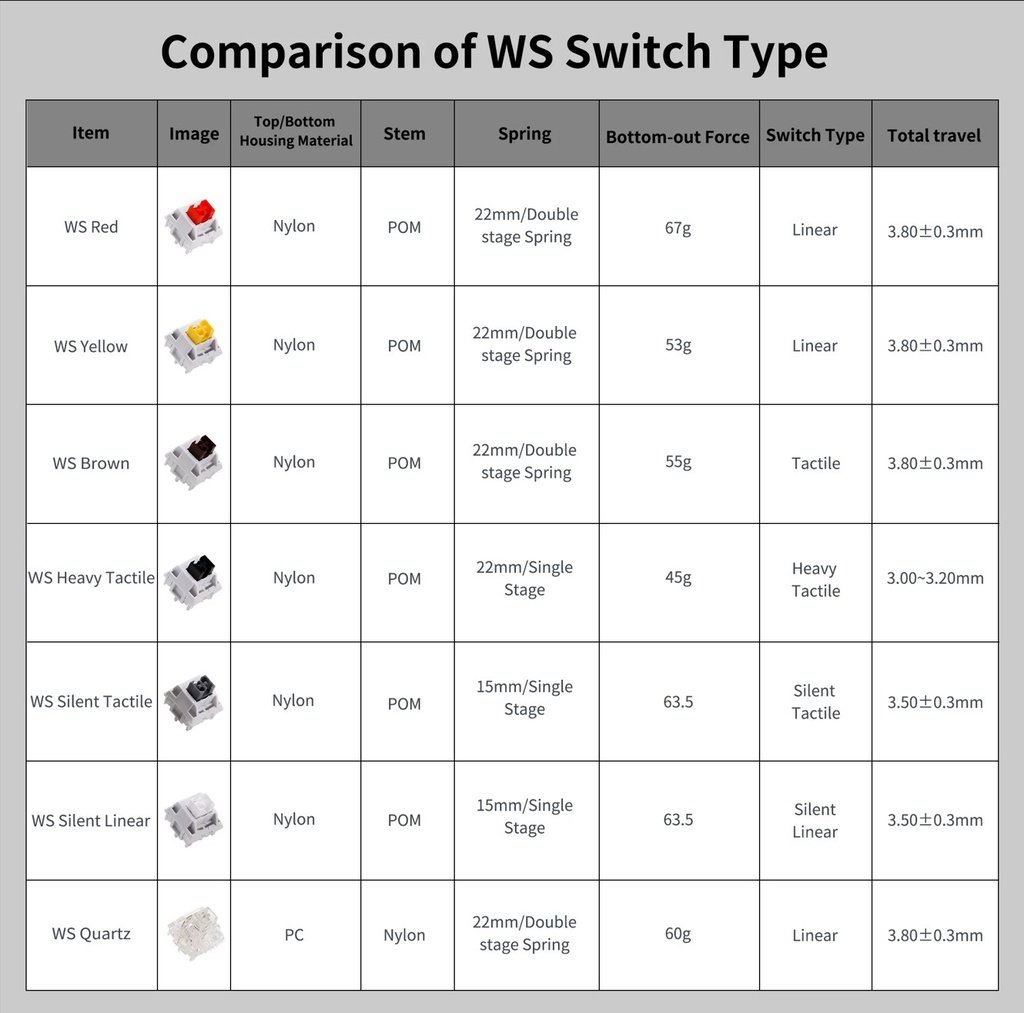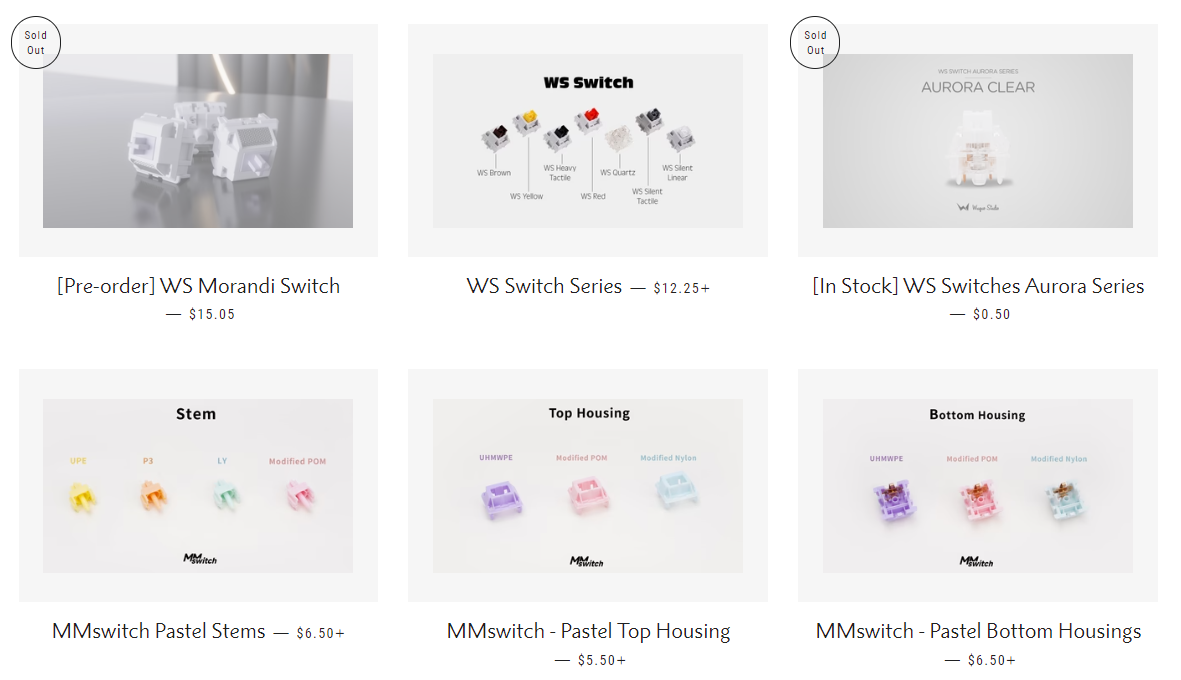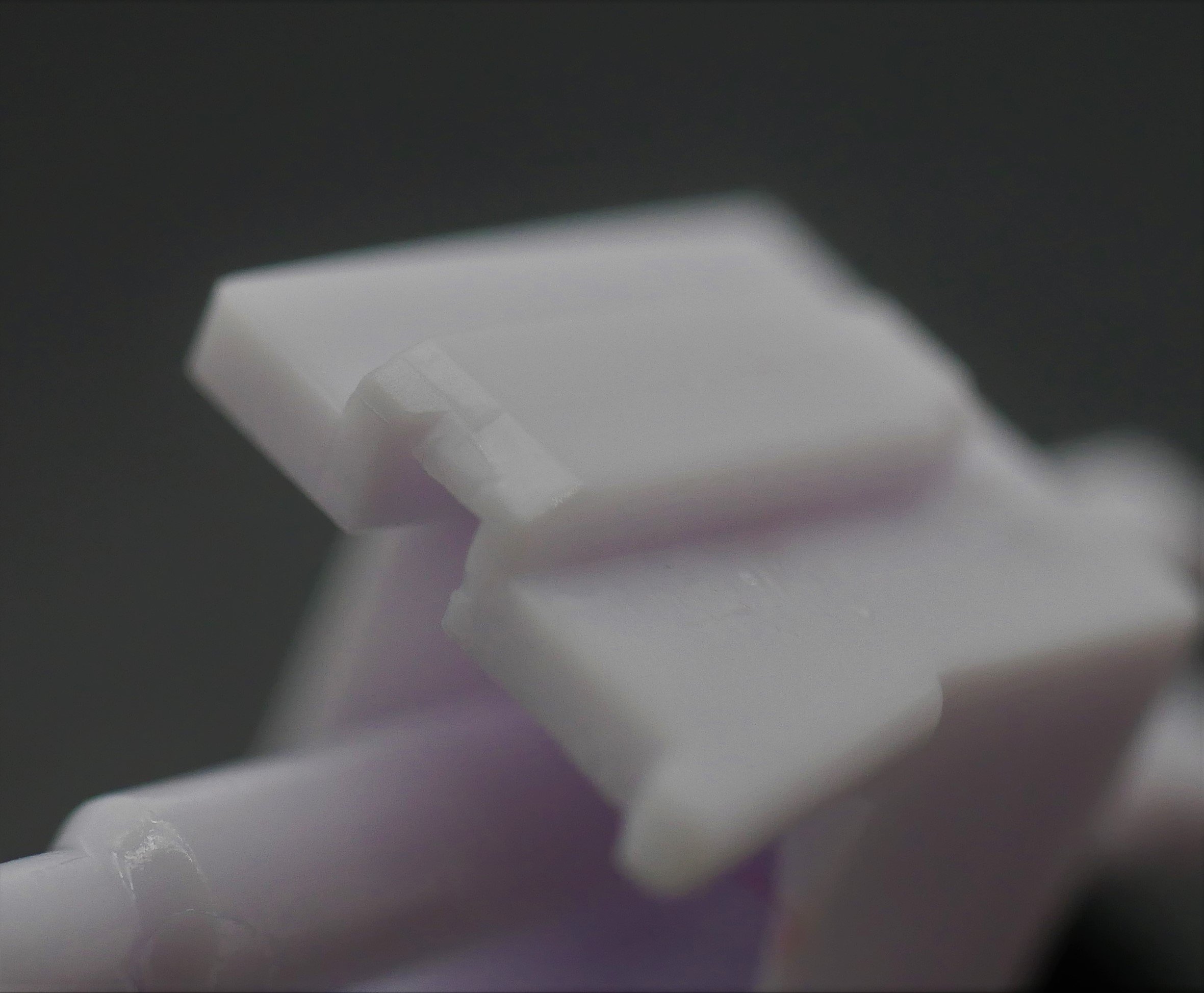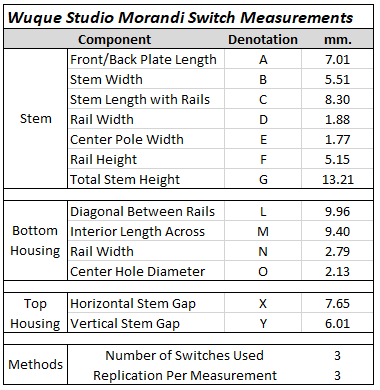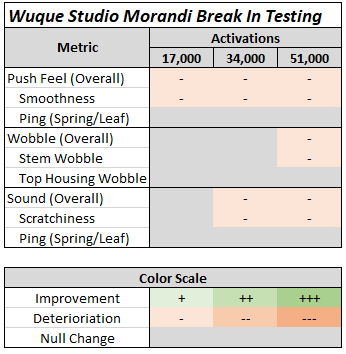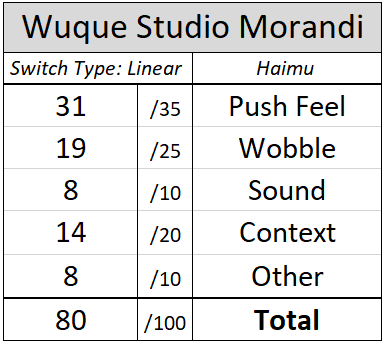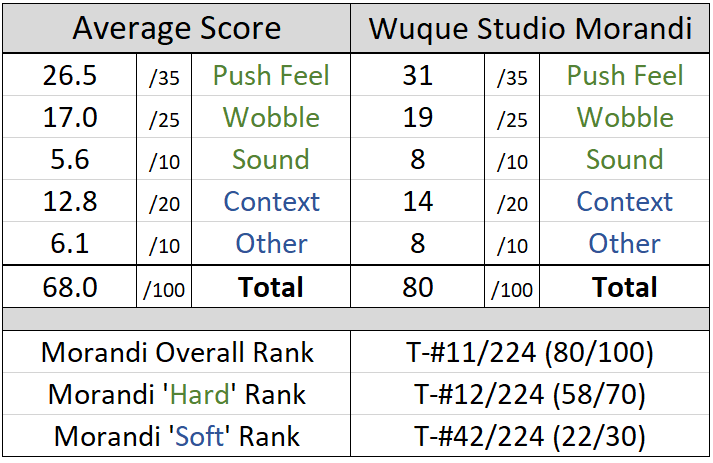Wuque Studio Morandi Switch Review
Officially at the tail end of professional work week number two, I must say that I am rather surprised at how quickly I’ve adapted to this new, strange environment as well as just how much better it is overall. I feel like I’m eating better, sleeping better, and even having less physical and metaphorical headaches on a day-to-day basis. Never mind the looming thought in the back of my mind of taking up Magic the Gathering again like I did over 6 years ago, I have money and health and I don’t need anything else to keep me satisfied! Aside from contemplating blowing my money on both cardboard and plastic in my free time, I’m also finally getting around to planning builds for keyboards that I’ve had sitting in boxes for far too long given my lack of time and willpower to get them made while in school. As I do get around to building those, I’ll be sure to share some here at the start of reviews, as people are asking me all the time what I am typing on for reviews week in and out. While I will say that I do rotate through keyboards depending on the mood and what is on my mind, this has been the review workhorse for the past dozen or two reviews:
Figure 1: Surprisingly the least shitty photo I could find of purple Petrichor with SA Phantom freshly after being built.
This deep-purple colored 1800 is a prototype keyboard designed by long time friend James of Alchemist Keyboards and is referred to as ‘Petrichor’. As of the time of writing this exact sentence I am breaking the fourth wall with here, the Petrichor features Bolsa Supply’s Techno Violet V2 switches on a carbon fiber plate and topped with a very well loved and shined set of SA Phantom keycaps which I will be retiring soon. While I very much did enjoy my time of writing on SA keycaps, the desire has waned a bit as my fingers having begun looking for something a bit less aggressive to type on. With that in mind, I did have a set of keycaps I think would go just right on this board…
Figure 2: Let me change into something a bit more... 'comfortable'
Switch Background
In my head, I really wanted to start out this background section by pointing out towards the Great Switch Ether and going on about how coming across ‘families’ of switches from specific makers and brands is such a rare but exciting concept that infrequently pops up. But as I sat down to actually write out that starting line of the paragraph, I was reminded at just how many branded families of switches that there are. In case you happen to have been blinded to this fact by all of the new and exciting switches released over the years, consider that all of the following are undeniably switch ‘families’:
- (Insert one here that I surely missed and will be reminded of by Reddit a dozen times over)
In this sudden revelation that I had had about all of these thematically driven groups of switch releases that I’ve come to accept as just immutable facts of life, I also came to the realization that the bar to clear to make that list has only become that much harder as it grows. A handful of years ago we might have been tempted to toss up the six releases of ‘Giant’ switches, Gateron Inks, and even smaller offerings like KNC Keys’ Squid Games switches onto that list, and yet all of these just feel a tad short of these long running, multi-release, and nearly immutable lines of highly marketed switches. As a result of this, as well, its impressive just how much large offerings of switches from specific designers have flown under the radar to both myself as well as the general public who is less glued to each and every switch release. Did you even realize Wuque Studios has had 15 different releases over the course of just the past few years?
Figure 3: They're even making charts now just to keep the details straight about one grouping of their many releases.
Even as someone who is thought of as having seemingly touched, tried, and hoarded nearly every MX-style switch there is to possibly get hands on, I will be the first to admit that I didn’t recognize Wuque’s offerings having ballooned up to 15 different ones. Last I remember checking, the Original Aspirations (OAs) and Onion switches were about it in terms of unique switch offerings from WS, first appearing in late 2020 and early 2021, respecitively. While both of these releases had their strengths and weaknesses relative to other offerings of their day, perhaps one of the consistently weaker aspects of Wuque’s switch releases has been their lack of marketing. Sure, the OA’s, Onions, and most recent ‘WS’ and ‘Aurora’ releases all had an insane amount of supporting vendors behind them including the US, Canada, Oceania, ‘Middle EU’, ‘West EU’, UK, Japan, South Korea, Singapore, Philippines, Malaysia, Taiwan, Thailand, India, and Indonesia, though without much notice behind them I suspect people more or less have stumbled into these offerings rather than intentionally sought them out with earnest as soon as they dropped for sale. For example, over the same span of just a handful of months that separated the OA and Onion switches back in 2020 and 2021, Wuque Studios has released 8 different Haimu-made offerings including the Morandis through the tail end of 2022 into 2023.
Figure 4: Most recent display of Wuque Studio switch offerings not including Original Aspirations or Onions from their website.
Furthermore, on top of all of these usable in stock form releases, Wuque Studios also took on a switch-history first in offering an entire line of switches in a ‘mix and matchable’ format across several different vendors at once. Dubbed ‘MM Switches’ for Mix-and-Match, these sets of springs, housings, and stems combined to 180 different possible combinations available in a variety of color and material combinations. While I have yet to build all possible combinations of them, myself, I was sure to pick up many boxes of this unique piece of switch history back in Q3 2022 in order to not miss out on the chance to try them out. And even then, the fact that I’ve still not built them more than a half year down the road should be even more proof of just how easily people seem to internalize and forget about all of the new Wuque offerings out there regardless of how frequently or historically neat their releases are. These new Morandi switches being released, as well, are no exception to this quiet release style either.
First announced absolutely never, the Wuque Studio Morandi switches first popped up on my radar about a week prior to writing this review, showing up as ‘Out of Stock’ on a range of different vendor’s websites. Assumedly accidentally becoming available for sale on one of those websites for a brief while since they very quickly went out of stock less than a few hours later, I placed my order earlier this week and have yet to heard a single person mention of their existence. Made by Haimu, like the last handful of Wuque Studio releases, the Morandis will eventually be made available for purchase to the general public at a price of $0.43 per switch as is currently listed on the sales page of Wuque Studios. The Wuque Studio (or WS) Morandis are listed as POM-housed linear switches with a ‘UPE’ stem and shortened travel distance, bottoming out at a fairly average 60g of force. Much like with anything Wuque has done switch wise, I do not have the slightest bit of clue about any of their plans or details surrounding the Morandis at all.
Morandi Switch Performance
Appearance
At the highest level, the Wuque Studio Morandi switches fall in line with all of the design trends seen in recent Haimu switch releases: four pin top housings connected to 5-pin, PCB mount bottom housings and large, textured LED diffusers occupying the space where LEDs would normally reside. The Morandi switches, specifically, come in entirely white POM housings with the absolute faintest color of purple they could possibly get on the stems. It’s so faint, in fact, that I suspect that the color was actually an accident in production where they somehow didn’t clean out the single molecule of purple dye left in the feed hopper prior to adding white plastic pellets to it. Beyond this nearly impossible to detect purple colored UPE stem and the textured top housings, though, there is little else in the way of easily identifiable features for the WS Morandi switches as they feature no nameplates nor many mold markings.
Figure 5: Wuque Studio Morandi switch and their components.
Looking a bit more closely into the top housings of the Morandis, the more distinguishing features of their design are more so ‘devils in the details’ than they are immediately obvious. The easiest distinguishing feature from that of other Haimu switches with the large LED diffusers, like the EMT V2s, is that the texturing on the top side of the diffuser is actually different. Unlike the flatter, more squared off pattern in the EMT V2s, the Morandi diffusers come in a highly textured, hexagonal pattern for some undiscernible reason. Beyond this, the only other identifying mold marking I was able to find anywhere in the top housings was that of a single number, upside down stamp on the interior side of the LED diffuser. The top housings had no mold numbering nor lettering and only featured a set of mold ejector circles along the upper internal rim of the housing as anything remotely identifiable.
Figure 6: WS Morandi top housing external design showing four pin attachment, lack of nameplate, and large, textured LED diffuser.
Figure 7: WS Morandi top housing internal design showing lack of distinctive mold markings and mold ejector circles around upper rim.
Figure 8: LED diffuser pattern comparison between WS Morandi (Left) and EMT V2 (Right), both of which are made by Haimu.
Moving onto the stems of the Morandi switches, there again isn’t much in the way of immediately interesting points about their design. Made of the nebulous “ultra-high molecular weight” polyethylene (UPE) these 13.21 mm stems are fairly bog-standard linears with slightly tapered slider rails and a rather harshly tiered center pole which bears the brunt of the bottoming out. Mold ejector circles are located on the far edges of the back plate, which features a pair of slanted corners as has been seen in a couple of switches prior to these. The only real point of note with these stems I encountered accidentally while measuring them is that they are very soft. Normally, I can squeeze down on certain stem dimensions fairly well with my calipers until I get a fixed value, and for most switches the variation between loose and tight grips on these dimensions varies only a few hundredths of a millimeter. These stems, on the other hand, were able to flex up to a tenth of a millimeter in more than a few directions, and I even managed to dent the slider rail with a lot less force than I’ve applied to some stems before supposedly also made of polyethylene. Given that polyethylene (presumably the only ingredient in UPE stems) is not ever this soft, I really am at a loss as to how a “UPE” this soft was chosen for a relatively brutal occupation in a mechanical keyboard switch stem.
Figure 9: Front and backside of WS Morandi stems showing non-squared off backplate edges, tapered slider rails, and tiered center pole.
Figure 10: Contrast boosted image of chipped slider rail bottom from simple caliper measurements.
Finally arriving at the bottom housings of the Morandi switches, there are a few surprising and different details that I don’t recall having ever seen in a full-length review on this website yet. Firstly, on the interior the leaves are silvered almost entirely in color with the exception of the copper colored contact points between the short and tall leaves. While silvered leaves have been see in rare few MX-style switches before, the vast majority have leaves that are coated with copper. Looking beyond this strange detail, the internal basin of the bottom housing has features which have been seen previously in various combinations in other switches including slightly padded slider rail bottom outs, a slight lip around the center pole hole, and some mold ejector circles within the base. On the underside of the bottom housing, the traditional PCB mounting pins, diode symbol, and mold marking are all shoved more tightly together than in most other switches. To the right of the diode symbol which almost contacts both the center pole hole and the large LED-diffuser slot, the mold number features a number followed by a capital letter – a location and design which I have not previously seen from any Haimu switches. Additionally, the ‘silencing holes’ between the PCB mounting pins and the center pole hole that have become well associated with Haimu are also completely absent in this switch, making the molds for the Morandis potentially custom owned by Wuque.
Push Feel
While there are plenty of little niche details in the design of the switches that subvert the expectations of more detail-oriented switch people out there, I can assure you that the surprises do not just stop there. Looking at the sales page for WS Morandis, everybody and their dog are almost certainly going to make assumptions on how these sound and feel purely based on the lone detail that the top and bottom housings are both made of POM. Go ahead and throw those expectations out completely. The housing collisions in the Morandis are perhaps the biggest star of the entire show in that they are extremely firm, muted, and thick feeling with the most reasonable approximation being an original Cherry MX switch. Furthermore, even with only a tiny bit of factory lubrication on the stems themselves, the switches are smooth enough to be usable out of the box but have just enough of that POM character left to them that it’s not just slip-and-slide smooth. Even though this is not the comparison section, the sum total of details about the housing collisions and smoothness really make the Wuque Morandis, a POM and UPE switch made by Haimu with absolutely no marketing whatsoever, one of the closest analogues to an original nylon Cherry linear switch to date.
Further delving into the finer details of the push feeling of the Morandis, it is not as if they are technically perfect to the finest detail. Even though the switches are consistent enough across the batch in terms of their housing collision feelings and general smoothness, there are a few which feel slightly thinner at bottoming out and more scratchy than others. The more thin bottoming outs, I suspect, are a function of the stem hitting more pointedly on the bottom housings, something which does have a decent amount of separation from the topping out feeling though doesn’t have the same fatiguing collision strength of more classic long-pole switches. While these are perhaps rather nitpicky points for even me to go after in terms of variability when these issues only affect maybe 10 to 20% of the switches in the batch, it really does highlight the level of fine-tooth comb that these switches can be subjected to fresh out of the box and still hold up.
Figure 11: Wuque Studio Morandi force curve diagram.
Sound
I have no doubt that following that last section people are hurriedly skipping here hoping that a near analogue for Cherry has also been found in sound as well as in the push feeling of the switch. Unfortunately, while the Morandis are rather deep, muted, and much more towards the quiet end of the spectrum than most non-silent switches, they don’t quite carry the same level of muteness that Cherry’s housings do. A large part of this is a function of the long stem pole and shortened travel distance of the Morandis, something which gives the only somewhat loud sound to the switch at all. As a side note, this pitch and tone at bottoming out also doesn’t change much at faster typing speeds as well, something which is fairly uncommon for long-pole linear switches. As well, the subtle variability in factory lubrication also catches up to the Morandis here with that same 10-20% variability popping up in the form of some extremely subtle spring ping. While I doubt that many people will audibly pick up this ping in in-hand testing or when used in board designs that are popular in this day and age, more hollow and reverberation-heavy cases (e.g. CA66) may make this note much more prevalent if used.
Wobble
For as strong of a performance as the Wuque Studio Morandis put up, the stem wobble is perhaps the most frustratingly average thing about their entire design. Do recent Haimu releases perhaps have a slight edge up over the average stem wobble of all modern MX-style switches? Yes, and ever so slightly in the E/W direction. However, the N/S direction falls more or less in line with most notable offerings of the past half year and it is frustrating they couldn’t be just a touch better on this point. Variability, thankfully, doesn’t seem to have struck this to any noticeable degree as the stem wobble is consistent in both directions across my entire batch.
Measurements
If you’re into this level of detail about your switches, you should know that I have a switch measurement sheet that logs all of this data, as well as many other cool features which can be found under the ‘Archive’ tab at the top of this page or by clicking on the card above. Known as the ‘Measurement Sheet’, this sheet typically gets updated weekly and aims to take physical measurements of various switch components to compare mold designs on a brand-by-brand basis as well as provide a rough frankenswitching estimation sheet for combining various stems and top housings.
Figure 13: Wuque Studio Morandi switch 'butterfly style' force curve diagram.
Figure 14: Numerical details regarding the stock Wuque Studio Morandi switch force curve diagram.
The latest in the content-adjacent work that I’ve picked up, the new ‘Force Curve Repository’ is now hosted on GitHub alongside the Scorecard Repository and contains all force curves that I make both within and outside of reviews. In addition to having these graphs above, I have various other versions of the graphs, raw data, and my processed data all available for each switch to use as you please. Check it out via the ‘Archive’ tab at the top of this page or by clicking any of the force curve cards above.
Break In
Break In Notes
17,000 Actuations
- At 17,000 actuations, the only noticeable change in the Wuque Studio Morandi switches is that smoothness of the switches becomes less consistent across the batch that was broken in. Even though most of the switches still maintain that smooth yet slightly scratchy feeling that was described above, the few that were outliers at the start only became a bit more scratchy after breaking them in.
- Beyond this change in smoothness assumedly caused by migration of factory lubrication, there were no other changes that would commonly follow with such a phenomena like changing in bottoming out strength or sound.
34,000 Actuations
- At 34,000 actuations, the same note from the previous break in marker about inconsistency in smoothness across the batch of switches remains, though it doesn’t increase or change to any real noticeable degree.
- While there were not really any changes to the pitch or volume of the Morandi switches at 17,000 actuations, after one more hour of breaking them in the volume of the switches increases rather noticeably to the point that they sound a lot less like the Cherry analogue comparison made in the review above and more so like what you would expect from entirely POM-based housings.
51,000 Actuations
- Surprisingly resilient to distinct changes in stem wobble, it wasn’t until about 51,000 actuations that the Morandis began to show any increased stem wobble as a result of the breaking in testing. This was especially noticeable in the E/W direction over that of the N/S direction.
- Much like with the previous rounds of testing, the Morandi switches broken in to 51,000 actuations carry all of the same changes from the previous rounds forward and don’t seem to increase or change along those lines much if at all.
Comparison Notes to Other Notable Linear Switches
Note – These are not aimed at being comprehensive comparisons between all factors of these switches as this would simply be too long for this writeup. These are little notes of interest I generated when comparing these switches to the Wuque Studio Morandi switches side by side.
Figure 16: Switches for comparison. (L-R, Top-Bot: Novelkeys Cream, Cherry MX 'New Nixie', EMT V2, Gateron Cream Soda, TTC Matrix 01 Linear, and Husky)
Novelkeys Cream
- For both being made with all POM housings, the Morandi switches are significantly more firm, solid, and muted feeling than the Novelkeys Cream switches. In fact, I would say that the Morandi are closer to Cherry MX switches in terms of the thickness of housing collisions than they are Creams.
- As would be expected from a comparison as such, the Morandi switches are also quite a bit more quiet and bass-heavy in their bottoming outs than the comparatively thinner, higher pitched Novelkeys Creams.
- There is more N/S and E/W direction stem wobble in the Creams than is in the Morandi switches, and especially in the E/W direction comparison.
Cherry MX ‘New Nixie’
- In terms of both overall sound profile and volume, the New Nixies and the Morandi are the most similar out of any of the switrches in this comparison list.
- The Cherry MX ‘New Nixies’ and the Wuque Studio Morandi are also quite similar to each other in terms of smoothness, with both having a noticeable but not overwhelming amount of scratch that adds character to their stroke.
- The New Nixie switches are similar to the Morandis in terms of E/W stem wobble, but a tiny bit better in the N/S direction.
EMT V2
- Interestingly, I had pointed out in my Gecko Silent Linear Switch Review that Haimu switches had been using the holes in the bases of their bottom housings to help dampen sound – a feature which the EMT V2 switches have. Yet, even though the Morandi switches are both made by Haimu and missing those holes, they are distinctively more quiet and muted in their housing collisions.
- The EMT V2 switches are similar to the Morandi switches in terms of E/W direction stem wobble, but perhaps just a slight bit more wobbly in the N/S direction when comparing the batches of each that I received.
- While the bottoming out of both of these switches is a bit pointed as a result of their longer stem pole, the ostensibly thicker POM housings in Morandis makes their bottoming out feel a bit more firm and distinct.
Gateron Cream Soda
- Even with similar feelings and travel distances in mind, the Morandi switches just pack that extra little depth to their bottoming and topping out that makes them feel ever so slightly more polished and well rounded than the Gateron Cream Soda switches.
- While these two switches have similar overall volumes to each other at normal typing speeds, at higher speeds the Gateron Cream Sodas begin to increase both in volume and pitch whereas the Morandi switches do not.
- On average, the Gateron Cream Soda switches across a batch are slightly smoother and clearly have better dialed in factory lubrication than the Wuque Studio Morandi switches.
TTC Matrix 01 Linear
- Even though the bottoming out of the Morandi switches is a bit more firm and solid feeling, the general strength of the impact at bottoming out between the Matrix 01 Linears and the Morandis is the most similar of any of the switches on this comparison list.
- In terms of smoothness, there is quite a bit more scratch to the TTC Matrix 01 Linear switches than there is in the Morandi switches, which themselves are by no means the smoothest linears.
- Much like with the stem wobble comparison made for the EMT V2 switches, the TTC Matrix 01 Linear switches are more wobbly than the Morandis in the N/S direction while maintaining a similar degree of wobble in the E/W direction.
Husky
- In terms of the overall volume and pitch, the Husky and Morandi switches could not be more diametrically opposed. Whereas the Huskies are intentionally on the higher pitched, thinner sounding end, they do well to really contrast the impressively deep, thick sound of the Morandis.
- Directly comparing their housing collisions, the bottoming out of the Morandi switches carries a bit more force and heft to it that the Husky switches do not.
- All things equal, the smoothness of the Husky and Morandi switches are actually fairly close to each other and likely could be confused on this metric (and this metric alone) during blind testing.
Scores and Statistics
Note – These scores are not necessarily completely indicative of the nuanced review above. If you’ve skipped straight to this section, I can only recommend that you at least glance at the other sections above in order to get a stronger idea of my opinion about these switches.
Push Feel
Marketed as having UPE stems that bottom out at 60g in an entirely POM-based housing, it would be easy to draw conclusions about how the Morandis feel out of the box. Editorial note here: Those would be wrong conclusions. These switches have a slightly unbalanced set of incredibly deep, firm, and nearly nylon-like housing collisions on either end of a smooth yet subtly scratchy character that makes these switches feel about as close to an original Cherry MX switch that any modern attempt has come near yet.
Wobble
The most frustratingly ‘average’ feature of the WS Morandi switches is their somewhat noticeable but likely unproblematic amount of stem wobble in both directions, and especially the N/S one. While perhaps better than the true average of all modern switches ever, it’s frustratingly okay for the higher end of releases in recent years.
Sound
Sitting on the very quiet end of the total volume spectrum, the Morandis carry the same depth from their push feeling over into the sound though with a bit more separation between the housing collisions because of the bottoming out onto the stem pole.
Context
The one thing which Wuque Studios has nailed down with these switches is flat out mystery. Sure, the price and breadth of vendors stocking these really helps their potential to gain steam within the community, but without any sort of idea as to their longevity, planned release date, or anything else that fills out the context surrounding a switch, it’s extremely hard to gauge just how good these switches will look in six months’ time.
Other
Aside the lack of any detail before release, they absolutely blew away all initial thoughts I had had about their marketing specs in a fashion that is almost too good to believe
Statistics
If you are looking at this statistics section for the first time and wondering where the hell are the other 223 switches that I’ve ranked are, or what ‘hard’ versus ‘soft’ ranks refer to specifically, I’d encourage you to head on over to my GitHub linked in the table above or at the links in the top right hand of this website to check out my database of scorecards as well as the ‘Composite Score Sheet’ which has a full listing of the rankings for each and every switch I’ve ranked thus far.
Final Conclusions
Honestly, the only feelings I am left with at the end of writing this review is a weird mixture of impressed and genuine doubt. On the more easy to articulate side of things, the Wuque Studio Morandi switches are strong in their performance and offer deep, firm housing collisions at the ends of otherwise smooth but not overly smooth characteristic that is still likely usable out of the box by many. Sure, there are small nitpicky details here or there that could be pointed to as weak such as their stem wobble, minor inconsistencies across the batch received, and even in their break in performance, but yet we have all seen much worse performances on each of these metrics on switches that have shown up in full length reviews on this website. What is impressive, however, is the fact that this performance and these characteristics simply do not line up with the marketing for these switches in the slightest. If you had asked me in good faith up to the past few days what I would expect a Haimu made switch with housings made entirely of POM to sound and perform like, you would think that I was talking about an entirely different switch than what my review above belays. And that is where that edge of genuine doubt about the marketing comes in underneath the impressed feelings. In fact, I’m almost somewhat concerned that just how expectation breaking this switch is based on the comparison between in-hand testing and marketing has somehow tricked me into thinking these are better performing switches than they actually are.
Unfortunately, the biggest issue left with the Wuque Studio Morandi switches at the end of this all is the first two thirds of their name: Wuque Studio. This isn’t me pretending like there is some drama to dredge up with the company or their products, as at the bare minimum their track record with switches has only been trending better and better with each subsequent release. The problem stems from the fact that they simply don’t market their switches and seem as if they are taking a more laissez-faire attitude as to whether or not any switches survives the next handful of hours until they release their next round of designs to their dozen or more vendors. If ever there was a switch to grip down on as an offering, buy several hundred thousand of them, and then pump the profits back into improving those minor technical deficiencies in order to corner a good amount of market attention, this is the one. So for as good (and genuinely unexpected) a performance that the Morandi switches have given here in this review, I have absolutely no clue what they will look like or how they will be thought of months and years down the road. Not a clue.
Sponsors/Affiliates
Mechbox UK
- A wonderful UK based operation which sells singles to switches that I’ve used above in my comparisons for collectors and the curious alike. Matt has gone out of his way to help me build out big parts of my collection, and buying something using this link supports him as well as my content!
KeebCats UK
- A switch peripheral company based out of the UK which sells everything switch adjacent you could ask for, they’ve been a huge help recently with my film and lube supply for personal builds, and they want to extend that help to you too. Use code ‘GOAT’ for 10% off your order when you check them out!
proto[Typist] Keyboards
- An all-things keyboard vendor based out of the UK, proto[Typist] is a regular stocker of everything from switches to the latest keyboard and keycap groupbuys. While I’ve bought things from the many times in the past, they also are a sponsor of my work and allow me to get some of the great switches I write about!
MKUltra Corporation
- We may have stolen a few government secrets to get this one together. MKUltra is a US vendor that truly fills all the gaps other vendors simply don’t offer and is continuing to expand their switch and switch related peripherals by the day. Use code ‘GOAT’ for 5% off your order when you check them out!
Divinikey
- Not only do they stock just about everything related to keyboards and switches, but they’re super friendly and ship out pretty quick too. Divinikey has been a huge help to me and my builds over the last year or two of doing reviews and they’ll definitely hook you up. Use code ‘GOAT’ for 5% off your order when you check them out!
ZealPC
- Do they really need any introduction? Zeal and crew kicked off the custom switch scene many years ago with their iconic Zealios switches and the story of switches today couldn’t be told without them. Use code ‘GOAT’ (or click the link above) for 5% off your order when you check them out!
MechMods UK
- A rising vendor based in the UK, Ryan and crew have been a pleasure to work with and have nearly everything you’d need to build your first or fourteenth keyboard. Go build your latest or greatest one right now with them by using code ‘GOAT’ at checkout for a 5% discount!
Dangkeebs
- A longtime supporter of the website and the collection, Dangkeebs has quite possibly the widest variety of switches of any vendor out there. Not only is their switch selection large, but it rotates and is constantly adding new stuff too. You’re going to need 5% off your order with my affiliate to save off the cost of all those switches!
SwitchOddities
- The brainchild of one my most adventurous proxies, SwitchOddities is a place where you can try out all the fancy, strange, and eastern-exclusive switches that I flex on my maildays with. Follow my affiliate code and use code ‘GOAT’ at checkout to save 5% on some of the most interesting switches you’ll ever try!
Cannonkeys
- Does anybody not know of Cannonkeys at this point? One of the largest vendors in North America with keyboards, switches, keycaps, and literally everything you could ever want for a keyboard always in stock and with an incredibly dedicated and loving crew. Follow my affiliate link above in their name to support both them and I when you buy yourself some switches!
Kinetic Labs
- One of the most well-rounded keyboard vendors out there, Christian and crew have been supporters of all my switch and switch-adjacent needs for some years now. I’m honored to have them as an affiliate and think you should check them out using my affiliate link above to support both them and I when you check out their awesome products!


